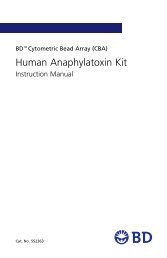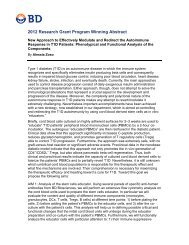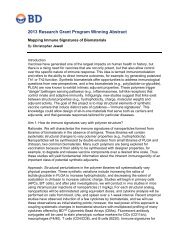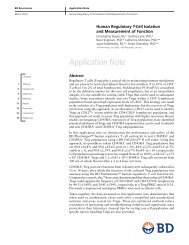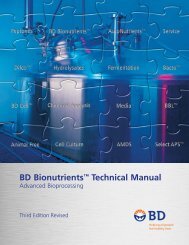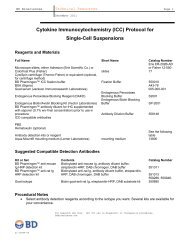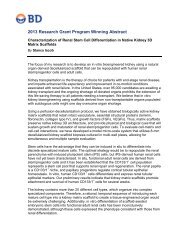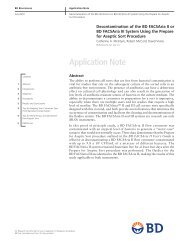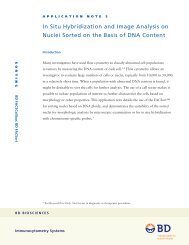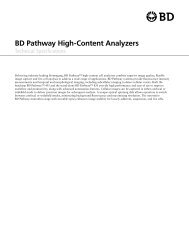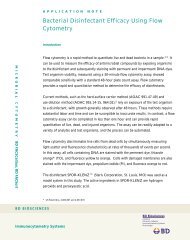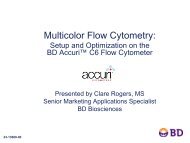BDTM Collagen - BD Biosciences
BDTM Collagen - BD Biosciences
BDTM Collagen - BD Biosciences
You also want an ePaper? Increase the reach of your titles
YUMPU automatically turns print PDFs into web optimized ePapers that Google loves.
<strong>BD</strong> <strong>Biosciences</strong><br />
<strong>BD</strong> TM<br />
<strong>Collagen</strong><br />
Frequently Asked Questions<br />
What is the source for <strong>BD</strong> <strong>Collagen</strong> I rat tail<br />
(<strong>BD</strong> Cat. Nos. 354236, 356236, 354249)?<br />
<strong>BD</strong> TM <strong>Collagen</strong> I rat tail is specifically derived from the tendons of 12 week old,<br />
virus-free, Sprague-Dawley Rats.<br />
The rats from which this material is derived:<br />
a) Have not been exposed to, or inoculated with, any livestock or poultry disease<br />
agents exotic to the US.<br />
b) Did not originate from a facility where work with exotic disease agents affecting<br />
livestock or avian species is conducted.<br />
c) This material is non-infectious and non-contagious.<br />
How is <strong>BD</strong> <strong>Collagen</strong> I rat tail extracted? Is there any enzymatic treatment?<br />
<strong>BD</strong> <strong>Collagen</strong> I rat tail is prepared from rat tail tendons by extraction into 0.5 M acetic<br />
acid and filtered (0.2 µm membrane). There are no enzyme digestion steps, so unlike<br />
<strong>BD</strong> <strong>Collagen</strong> from human and bovine sources, the helical ends are still intact for<br />
<strong>BD</strong> <strong>Collagen</strong> I rat tail.<br />
What are the applications for <strong>BD</strong> <strong>Collagen</strong> I rat tail?<br />
<strong>BD</strong> <strong>Collagen</strong> I rat tail may be used as a gel or as a thin coating on cell cultureware. The<br />
high concentration formulation of <strong>BD</strong> <strong>Collagen</strong> I rat tail (<strong>BD</strong> Cat. No. 354239) is used<br />
as a three dimensional gel. Cells may be cultured on top of the gel, within the gel, or<br />
between gel layers.<br />
How do you measure protein concentration of <strong>BD</strong> <strong>Collagen</strong> I rat tail?<br />
The protein concentration for <strong>BD</strong> <strong>Collagen</strong> I rat tail is measured by<br />
pyrochemiluminescence assay.<br />
How can I sterile filter <strong>BD</strong> <strong>Collagen</strong> I rat tail?<br />
<strong>BD</strong> <strong>Collagen</strong> I rat tail can be sterile filtered using a 0.2 µm membrane filter.<br />
What are the applications for <strong>BD</strong> <strong>Collagen</strong> I bovine (<strong>BD</strong> Cat. No. 354231)?<br />
<strong>BD</strong> <strong>Collagen</strong> I bovine may be used as a gel or as a thin coating on cell cultureware.<br />
Cells may be cultured on top of the gel, within the gel, or between gel layers.<br />
What are the applications for <strong>BD</strong> <strong>Collagen</strong> I human<br />
(<strong>BD</strong> Cat. Nos. 354243, 354265)?<br />
<strong>BD</strong> <strong>Collagen</strong> I human is generally used as a thin coating, but it may also be used as a<br />
gel, if desired.<br />
What are the applications for <strong>BD</strong> <strong>Collagen</strong> II bovine (<strong>BD</strong> Cat. No. 354257)?<br />
<strong>BD</strong> <strong>Collagen</strong> II bovine is used for attachment and differentiation of chondrocytes.<br />
It can be used as a thin coating on cell cultureware.<br />
Is <strong>BD</strong> <strong>Collagen</strong> II bovine intact?<br />
<strong>BD</strong> <strong>Collagen</strong> II bovine is pepsin digested so it is not intact. Pepsin digestion may leave<br />
cleavages or cause some degradation.<br />
Is <strong>BD</strong> <strong>Collagen</strong> III human (<strong>BD</strong> Cat. No. 354244) intact?<br />
This product may have cleavages.<br />
Frequen
For more technical information visit our website at: bdbiosciences.com<br />
To place an order in the US, contact Customer Service at 855.236.2772<br />
For technical assistance, contact Technical Support at 877.232.8995<br />
Outside the US, contact your local distributor or visit<br />
bdbiosciences.com/offices to locate your nearest <strong>BD</strong> <strong>Biosciences</strong> office.<br />
What are the applications for <strong>BD</strong> <strong>Collagen</strong> IV mouse<br />
(<strong>BD</strong> Cat. Nos. 354233, 356233)?<br />
<strong>BD</strong> <strong>Collagen</strong> IV mouse is generally used as a thin coating in the concentration range<br />
of 1-10 µg/cm 2 of growth surface. Higher concentrations may allow for longer term<br />
attachment. These are guidelines only. We recommend that each laboratory empirically<br />
determine the optimal conditions for their unique applications.<br />
What are the applications for <strong>BD</strong> <strong>Collagen</strong> IV human (<strong>BD</strong> Cat. No. 354245)?<br />
<strong>BD</strong> <strong>Collagen</strong> IV human is generally used as a thin coating, but it may also be used as a<br />
gel, if desired.<br />
Is <strong>BD</strong> <strong>Collagen</strong> V human pepsin-treated (<strong>BD</strong> Cat. No. 354246)?<br />
Yes, <strong>BD</strong> <strong>Collagen</strong> V human is pepsin-treated and therefore may have cleavages.<br />
Is <strong>BD</strong> <strong>Collagen</strong> VI human (<strong>BD</strong> Cat. No. 354261) pepsin-treated?<br />
Yes, we do use pepsin digestion in the process of <strong>BD</strong> <strong>Collagen</strong> VI human preparation.<br />
COLLAGEN: GENERAL INFORMATION<br />
What does a <strong>BD</strong> <strong>Collagen</strong> gel look like?<br />
A <strong>BD</strong> <strong>Collagen</strong> gel looks like an agarose gel, but it is more delicate. If touched with the<br />
end of a pipet, it will break apart.<br />
How stable is a <strong>BD</strong> <strong>Collagen</strong> gel over time?<br />
The gel will start to contract away from the edges of a dish after 2 weeks, so we do not<br />
suggest making a gel ahead of time.<br />
What is the storage recommendation for <strong>BD</strong> <strong>Collagen</strong> products?<br />
Storage recommendations for <strong>BD</strong> <strong>Collagen</strong> products vary from 4°C to -70°C,<br />
depending on the collagen type. Specific information can be found on the product<br />
specification sheet. Frozen <strong>Collagen</strong> products should not be stored in a frost-free freezer.<br />
Avoid multiple freeze-thaws.<br />
What is the stability for <strong>BD</strong> <strong>Collagen</strong> coating on a cultureware?<br />
We recommend air drying <strong>BD</strong> <strong>Collagen</strong>-coated cultureware and then storing it at 4°C<br />
in a sealed container that will help protect it from moisture. Under these conditions the<br />
coated cultureware should be stable for at least two weeks.<br />
Why is <strong>BD</strong> <strong>Collagen</strong> not gelling?<br />
<strong>BD</strong>, <strong>BD</strong> Logo and all other trademarks are property of Becton, Dickinson and Company. © 2012 <strong>BD</strong><br />
F12R291<br />
Protein concentration for <strong>Collagen</strong> varies from lot-to-lot. Normalize your calculations<br />
based on protein concentrations. It is critical the pH (eg, for <strong>BD</strong> <strong>Collagen</strong> I rat tail)<br />
should be as recommended in the product manual for collagen gelation. Make sure the<br />
product is stored as recommended and is not expired.<br />
<strong>BD</strong> <strong>Biosciences</strong><br />
296 Concord Road<br />
Billerica, MA 01821 USA<br />
bd.com/biosciences




